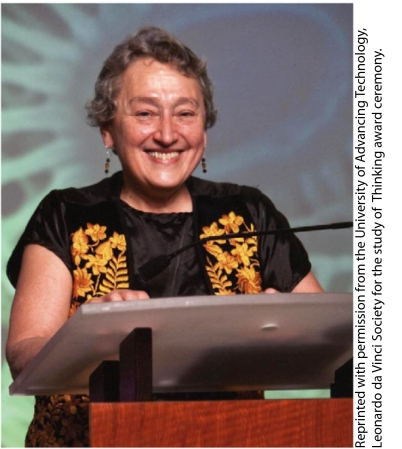On November 22, 2011, Lynn Margulis, visionary biologist and tireless champion of the microbial world, died of a massive stroke. Born in 1938, Lynn was intellectually precocious, earning her bachelor’s degree from the University of Chicago at age 18 and a Berkeley PhD 6 years later. Lynn’s enduring place in science was earned soon thereafter, with the publication of her theory of endosymbiosis, a radical and, as it turned out, lasting explanation for the origin of mitochondria and chloroplasts, the organelles responsible for energy metabolism in eukaryotic cells. In Lynn’s view, the chloroplast originated as a free-living cyanobacterium engulfed by a protozoan and reduced through time to metabolic slavery. Similarly, she hypothesized that the mitochondrion descended from an endosymbiotic bacterium capable of aerobic respiration. Unbeknownst to Lynn at the time, the Russian biologist Konstantin Merezhkovsky had published a similar proposal as early as 1905. However, Merezhkovsky’s ideas were largely ridiculed or forgotten, and when Margulis resurrected them, criticism was harsh. Some 15 journals rejected her first paper on endosymbiosis before it found a home in Journal of Theoretical Biology (1).
Lynn Margulis.
However, Margulis did more than rediscover endosymbiotic theory; she restated it in the then emerging language of cell and molecular biology, opening the idea to scientific test. In time, cell biologists showed that the chloroplast and mitochondrion are isolated from the rest of the cell by a set of enveloping membranes; moreover, both organelles contain DNA, previously thought to be restricted to the nucleus. These observations set up the crucial test of Lynn’s hypothesis. Comparisons of nucleotide sequence in genes from the chloroplast showed it to be related most closely to free-living cyanobacteria, not to nuclear DNA of the same cell. Also, mitochondria were shown to nest within the proteobacteria, another bacterial clade. Lynn was right: the eukaryotic cell is a committee, built through evolution by the merger of distinct genomes. To many biologists, this remarkable view of eukaryotic cell evolution stands as one of the great advances in 20th century science. Throughout her life, Lynn maintained as well that the flagellum, the whip-like structure responsible for locomotion in many eukaryotic cells, also originated as a symbiotic bacterium, but this theory has never garnered strong support from other biologists.
Endosymbiotic theory was only the beginning of Lynn’s unconventional career. She was an early advocate of the Gaia Hypothesis, James Lovelock’s proposal that life actively regulates Earth’s environment. Indeed, endosymbiosis and Gaia were linked in Lynn’s mind as components of a coherent alternative biology based on cooperation rather than competition. This view led Lynn to reject basic tenets of evolutionary theory, bringing her into lasting conflict with evolutionary biologists. Today, most biologists accept an expanded role for cooperation in ecology and evolution, but few endorse Lynn’s view that symbiosis drives speciation. She courted controversy until the end, questioning the role of HIV in causing AIDS in recent years.
Throughout her life, Lynn championed science education, especially in less developed countries. Fluent in Spanish, she was revered by students in Spain and Latin America for her unflagging efforts to help them learn. Generations of American students also benefitted from her engaging presence and enthusiastic support. I was one of them, both stimulated to study the early Earth by Lynn’s writings and from my first year of graduate school, welcomed as friend and colleague.
In my favorite memory of Lynn, she is crawling on the floor with my infant daughter, both of them giggling away. The maternal instinct was strong in Lynn, and it extended beyond her beloved children and the children of her friends. In a very real sense, students and colleagues who were curious about science were all her children. Lynn was also part evangelist, ceaselessly championing bacteria as the underappreciated architects of Earth’s biosphere.
After two decades on the faculty of Boston University, Lynn moved to the University of Massachusetts, where she was Distinguished University Professor at the time of her death. Her research earned her numerous honors, including the Darwin–Wallace Medal of the Linnean Society, the National Medal of Science, and membership in the National Academy of Sciences. Her books, several written with her son Dorion Sagan, include Origin of Eukaryotic Cells, Microcosmos, Five Kingdoms: An Illustrated Guide to the Phyla of Life on Earth, and Acquiring Genomes: A Theory of the Origins of Species (2–5). Marriages to Carl Sagan in 1958 and Nicholas Margulis in 1965 ended in divorce. Lynn is survived by her children Dorion Sagan, Jeremy Sagan, Zachary Margulis, and Jenny Margulis.
Lynn Margulis will long be remembered as a fountain of ideas—fertile, original, inspiring, contentious, and unedited. Lynn could infuriate her colleagues, but at least one of her proposals changed the way that we think about life. In conversation, Lynn seemed always to have the last word, and I am happy to grant it one last time. Earlier this year, in a comment that could stand as her epitaph, Lynn told an interviewer from Discover magazine, “I don’t consider my ideas controversial. I consider them right.”
Footnotes
The author declares no conflict of interest.
References
- 1.Sagan L. On the origin of mitosing cells. J Theoret Biol. 1967;14:255–274. doi: 10.1016/0022-5193(67)90079-3. [DOI] [PubMed] [Google Scholar]
- 2.Margulis L. Origin of Eukaryotic Cells. New Haven, CT: Yale University Press; 1970. [Google Scholar]
- 3.Margulis L, Sagan D. Acquiring Genomes: A Theory of the Origins of Species. New York: Perseus; 2002. [Google Scholar]
- 4.Margulis L, Schwartz KV. Five Kingdoms: An Illustrated Guide to the Phyla of Life on Earth. San Francisco: WH Freeman; 1982. [Google Scholar]
- 5.Margulis L, Sagan D. Microcosmos: Four Billion Years of Evolution from our Microbial Ancestors. New York: Summit; 1986. [Google Scholar]



